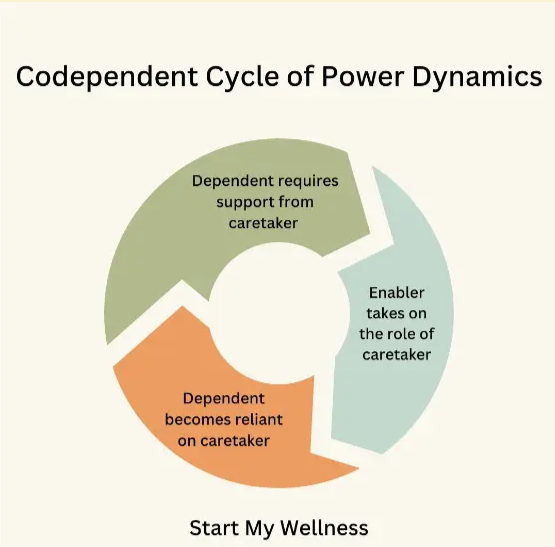In any relationship, the balance between giving and receiving is crucial for its health and longevity. However, when one person consistently places the other’s needs above their own, it significantly strains the relationship. On the other hand, when one person consistently places their own needs above their partner’s, that too can significantly strain the relationship. In situations where one or both partners are codependent or narcissistic , it can be challenging to navigate or understand the source of relationship issues.
Narcissism and codependency stand on opposite ends of the relationship spectrum. Narcissism involves exaggerated self-importance and a deep need for admiration. Conversely, codependency is a tendency to prioritize others’ needs above one’s own. Despite their differences, these two conditions can work together in a dysfunctional cycle, with one person only giving while the other is only receiving. While this dynamic relationship may show up in one’s romantic relationships, it can appear in any dyadic relationship such as between child and parent, siblings, or even between employer and employee.
Due to the complementary nature of codependency and narcissism, it’s essential for couples to recognize potential imbalances in their relationships and address them constructively. In this article, we will look at the overlap between codependency and narcissism with strategies for couples seeking balance in their relationships.
Understanding Codependency
Codependency is a behavioral condition where an individual sacrifices their own needs and well-being to focus on the needs of another, leading to a pattern of relationships that are unbalanced and often unhealthy. Codependent individuals tend to have low self-esteem, have trouble setting boundaries, and ignore their own needs to satisfy others.
This condition may stem from a fear of abandonment and an overwhelming desire for approval and affection which drive codependents to engage in enabling behaviors and take on a caretaker role. Despite their good intentions, this often results in a dependency on the approval of others for their self-worth, creating a vicious cycle.
Generally, it takes two individuals to create a codependent dynamic, each supporting the other in a dysfunctional, albeit complementary, relationship.
- The Dependent: relies on the caretaker for emotional, physical, or financial support. This individual can be self-sufficient but instead relies on the other individual for their well-being.
- The Caretaker: offers emotional and other support to the dependent, enabling them and relying on the dependent for approval and self-worth. While they provide a supporting role, they are still reliant on the other individual for esteem and validation.

Codependency Origins and Causes
Codependency originates from a complex interplay of psychological, emotional, and early childhood factors that contribute to its development in an individual’s life.
One of the primary origins of codependency is found in childhood experiences. Individuals who grew up in homes where emotional expression was discouraged or where parents were absent, neglectful, or abusive may develop codependent traits.
This environment teaches children to suppress their needs and feelings to maintain peace and balance. Additionally, these experiences can create a deep-seated belief that love and approval are conditional upon their ability to care for others.
Codependency can also be a learned behavior, where children of codependent parents view the relationship dynamic as normal. These children will adopt similar behaviors in their own relationships.
Recognizing Narcissism
Narcissism is characterized by an inflated sense of self-importance, a deep need for excessive attention, and a lack of empathy for others. However, it’s not always easy to identify, as narcissists can be highly charming and persuasive, especially in the early stages of a relationship.
While the term ‘narcissist’ is popular in modern culture as a way to express selfishness or ego, it’s important to recognize that Narcissistic Personality Disorder is a distinct condition that dramatically affects relationships and the ability to empathize with others.
Those with narcissistic personality disorder will often display the following traits, which indicate a dramatically inflated self-worth:
- Grandiosity: Narcissists often believe they are superior to others and deserve special treatment. They may boast about their achievements (real or exaggerated) and expect others to recognize their supposed superiority.
- Need for Admiration: Narcissists have a constant need for admiration and validation from those around them. They seek to be the center of attention and may become upset or angry if they feel they are not receiving the praise they deserve.
- Lack of Empathy: Narcissists struggle to recognize or validate the feelings and needs of others, often disregarding them entirely in favor of their own desires. This lack can lead to manipulative or abusive behavior in relationships.
- Exploitation in Relationships: Narcissists often engage in exploitative relationships, using others to achieve their own ends without consideration of the person’s well-being. They may take advantage of others’ kindness, generosity, or love.
Narcissism Origins and Causes
The origins of narcissism are multifaceted, involving genetic, psychological, and environmental factors. Unlike codependency, narcissism is more rooted in genetic factors, with a higher prevalence within families.
While a specific “narcissism gene” has not been identified (and it’s doubtful a single gene is involved), certain genetic traits may increase the risk. Additionally, biological factors, including brain structure and function, may contribute to narcissistic behaviors, although the exact mechanisms remain unclear.
Like codependency, early childhood experiences and the child’s environment play a large role in the condition. Parenting styles that are either overly permissive or extremely critical can contribute to the formation of narcissistic behaviors:
- Children who are excessively pampered, praised, and given a sense of entitlement may develop unrealistic self-perceptions and expectations.
- Conversely, children who experience neglect, abuse, or high parental expectations may use narcissism as a defense mechanism to cope with feelings of inadequacy.
Also similar to codependency but manifesting in a novel way, narcissism can arise from fragile self-esteem and an underlying sense of inferiority or vulnerability. To compensate for these feelings, individuals may construct a grandiose self-image and seek constant validation and admiration from others.
Thus, in both narcissism and codependency, an individual has poor self-esteem and self-worth that likely arose from poor models of validation experience in early childhood. The codependent is overt in their poor self-esteem, openly requiring others to validate them. The narcissist is much more covert, outwardly displaying confidence but inwardly requiring constant validation to maintain their inflated self-worth.
The Attraction: Why Codependents and Narcissists Gravitate Towards Each Other
The attraction between codependents and narcissists is a complex and often destructive dynamic that arises from their complementary, yet fundamentally unhealthy, needs. This dynamic has been referred to as a “dysfunctional dance,” where both parties engage in a cycle of control and caretaking.
While these relationships are complementary (each person balances the other), the give-and-take of the relationships is dramatically asymmetrical and toxic for both parties. Further, these relationships’ intensity and “passion” make them exciting and difficult to ignore.
In these relationships, the codependent takes on the role of the caregiver, while the narcissist relies on the caretaker for admiration and attention. Rather than both parties equally supporting one another, the caretaker takes on sole responsibility for the narcissist, who appears to not care for the caretaker.
As we explore the overlap between these two personality types in relationships, understanding why these types gravitate towards each other is critical to recognizing and addressing the underlying issues perpetuating this cycle.
Complementary Needs and Desires
At the heart of this attraction is the complementary nature of their needs and desires. Codependents, with their tendency to put others’ needs before their own, find a ‘seemingly’ perfect match in narcissists, who crave attention and admiration.
Codependents feel valued and purposeful by being able to care for or “fix” their narcissistic partners, often believing that this will earn them love and loyalty. Conversely, narcissists are drawn to codependents because of their willingness to cater to their ego, needs, and desires while offering little in return.
The Cycle of Control and Caretaking
The codependent-narcissist dynamic establishes a cycle of control and caretaking, where the narcissist’s demands and manipulation exploit the codependent’s fear of abandonment and desire for validation.
Additionally, the codependent’s actions reinforce the narcissist’s belief in their superiority and entitlement, further supporting inherent beliefs of self-worth. Over time, this cycle becomes increasingly difficult to break as each partner becomes more rooted in their role and mistakes the dysfunctional cycle for authentic intimacy.
Emotional Intensity and Confusion
The emotional intensity of these relationships can be misleading, often confused with depth or genuine connection. Codependents may interpret the narcissist’s attention and moments of affection as signs of true love, overlooking potential manipulations or emotional abuse.
Similarly, narcissists may feel a sense of control and validation from the codependent’s dedication and support, mistaking these for genuine care and admiration.
How do Narcissism and Codependency Impact Relationships?
For those potentially in a toxic relationship dynamic, the impact of either narcissism or codependency can be significant and far-reaching. The consequences of these relationships affect friends, family, and both partner’s broader social circle.
Participation in these relationships can lead to unhealthy patterns that carry over into other relationships and potentially undermine trust, respect, and mutual support with friends and family.
Erosion of Trust and Communication
In dysfunctional relationships, trust and communication suffer greatly. Narcissists, driven by their need for admiration and control, may resort to manipulation, gaslighting, and emotional abuse to maintain their position of power.
This behavior can deeply erode trust, leaving the codependent partner feeling confused, insecure, and unable to voice their needs or concerns. The lack of genuine, empathetic communication further isolates the codependent, making it difficult for them to seek help or support.
Patterns of Abuse and Control
The emotional toll on both partners can be significant. Codependents may experience feelings of worthlessness, anxiety, and depression as they struggle to meet the impossible demands of their narcissistic partner.
Their self-esteem becomes increasingly tied to their ability to please the narcissist, leading to a cycle of self-neglect and emotional depletion. Narcissists, on the other hand, may experience frustration, anger, and dissatisfaction when their expectations are not met, leading to further manipulations and abusive behaviors.
The Cycle of Reinforcement
The interaction between a narcissist and a codependent can reinforce and exacerbate the unhealthy traits of both. The codependent’s actions enable the narcissist’s behavior while neglecting their own needs and boundaries.
This dynamic not only reinforces the narcissist’s belief in their superiority but also deepens the codependent’s sense of dependency and low self-worth, trapping both individuals in the dysfunctional cycle.
Impact on Children and Family Dynamics
When these relationships occur within a family setting, the impact can extend to children and other family members. Children raised in environments marked by narcissistic and codependent dynamics may develop distorted views of relationships, self-worth, and emotional regulation. They may learn to associate love with conditionality, control, or neglect, carrying these patterns into their own future relationships.
Breaking the Cycle: Challenges and Considerations
Due to the intensity and confusion of toxic relationships, it can be overwhelming and challenging to know where to start or how to break the cycle. Breaking the cycle of narcissism and codependency requires significant emotional work and commitment from both individuals.
In understanding the challenges and considerations involved, individuals can take the first steps to break free of harmful relationships and become more secure and internally validated.
Recognizing the Problem
The first and primary hurdle of overcoming a toxic relationship is recognizing the problem. For codependents, this may involve coming to terms with their patterns of self-neglect and excessive caretaking. Acknowledging that their behavior is not just a form of selflessness but a potentially harmful pattern is rightfully challenging.
For narcissists, recognition is often more difficult, as their behaviors are deeply rooted in their sense of identity and self-worth. Admitting to manipulative or abusive behavior contradicts their sense of grandiosity and self-worth, creating a significant barrier to change.
Fear of Change and Loss
The fear of change and the potential loss of the relationship can paralyze both individuals. Codependents may fear that setting boundaries or asserting their needs will lead to abandonment or retaliation.
For narcissists, the fear of losing control of facing their vulnerabilities can prevent them from engaging in the introspection and change necessary to break the cycle.
The Role of Therapy
While breaking any cycle can be extremely challenging, doing so becomes much more approachable when done in a secure and neutral space with a licensed therapist or counselor.
For codependents, therapy can offer a space to explore their patterns of behavior, build self-esteem, and learn healthy ways of relating to others.
For narcissists, engaging in therapy can be challenging due to their reluctance to acknowledge their issues. However, tailored therapeutic approaches that focus on building empathy, addressing underlying insecurities, and improving communication can be effective.
Strategies for Healing and Recovery
While potentially toxic relationships are complicated to navigate, having professional guidance can help one or both individuals recognize their current steps in the mental health journey and where to take the next step.
Professional therapy and counseling offer a structured and informed approach to understanding and modifying the behaviors and thought patterns that contribute to codependency or narcissism.
One of the key benefits of professional guidance is the personalized care and tailored therapeutic strategies that address the unique needs of each individual. For codependents, therapy can focus on:
- Enhancing self-esteem
- Developing autonomy
- Learning to establish boundaries
For narcissists, therapy may concentrate on:
- Fostering empathy
- Recognizing the value of others
- Dealing with underlying insecurities
Below are the following therapy strategies to help manage these conditions.
Individual Therapy
For both narcissists and codependents, individual therapy is a cornerstone of better mental health. Cognitive Behavioral Therapy (CBT) is particularly effective in helping individuals recognize and change harmful thought patterns and behaviors.
- For codependents, therapy can focus on building self-esteem, learning to set healthy boundaries, and addressing past traumas that contribute to codependent behaviors.
- For narcissists, therapy may involve working on empathy, understanding the impact of their behavior on others, and dealing with underlying issues of self-esteem and vulnerability.
Additionally, narcissists can benefit from psychoanalytic psychotherapy. In this therapy, individuals bring up unconscious or repressed thoughts and examine them neutrally so that they may better understand how early experiences or traumas have impacted their current mental health.
Couples Therapy
When both partners are committed to improving their relationship and addressing the dynamics of narcissism and codependency, couples therapy is a valuable tool. This therapy helps both partners:
- Understand the impact of their behaviors on one another
- Learn effective communication skills
- Work towards establishing a healthy relationship dynamic
Group Therapy
Group therapy and support groups offer a unique environment where individuals can share experiences, gain insights, and receive support from others facing similar challenges.
Codependents can benefit from Codependents Anonymous (CoDA) or similar support groups, which provide a platform to learn from others’ experiences and develop healthier relationship skills.
Recovery from the effects of narcissism and codependency is a journey that requires patience, commitment, and self-compassion. While challenges are inevitable, the strategies outlined above can provide a roadmap for healing and the development of healthier, more fulfilling relationships.
Build Better Relationships and a Better You with Start My Wellness
Navigating the complexities of narcissism and codependency within relationships is a challenging journey, but it is not one that individuals must undertake alone. Professional guidance plays a pivotal role in both understanding these dynamics and starting your journey to better mental wellness.
Start My Wellness is here to guide you through the complexities of potentially toxic relationship dynamics or partners. We understand how difficult these situations can be and how hard it is to get out of them. Our team of experienced therapists and counselors specializes in personalized strategies to address your unique needs.
Don’t let the cycle of unhealthy relationship dynamics control your life any longer. Take the first step towards a more balanced and fulfilling life. Contact Start My Wellness at 248-514-4955 or meet our therapists today to get started.
Sources
- Mental Health America: Co-Dependency
- Start My Wellness: The Difference Between Codependency and Interdependence
- National Library of Medicine: Narcissistic Personality Disorder
- Health Direct: Narcissistic Personality Disorder
- National Library of Medicine: A Behavioral Genetic Study of Intrapersonal and Interpersonal Dimensions of Narcissism
- Counseling Today: The Dance Between Codependents and Narcissists
- Simply Psychology: Narcissist and Codependent Toxic Compatibility in Relationships
- Start My Wellness: Cognitive Behavioral Therapy
- MedScape: Narcissistic Personality Disorder Treatment and Management
- Start My Wellness: Couples Therapy
- Start My Wellness: Group Therapy
- CoDA: Codependency Anonymous Home Page

Author: Anton Babushkin, PhD
Looking for a Therapist? Start My Wellness has highly experienced Licensed Therapists that are currently accepting new patients.


